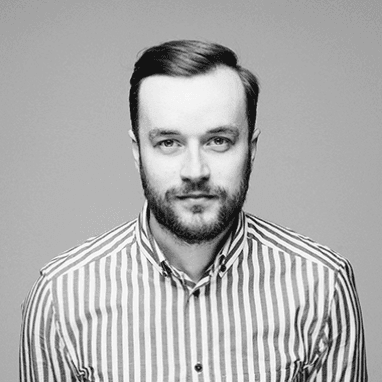What makes an app successful? How can you avoid budget overruns, and where should you not cut costs? Gracjan, a Senior Project Manager at mobitouch, answers these and many other questions. With years of experience in managing IT projects effectively, he shares insights from his work, takes us behind the scenes of project management, and provides tips on how to smoothly guide a project from start to launch.
Why you need a Project Manager when creating an app. Interview with Gracjan Walczak.
About Gracjan:
A Senior Project Manager skilled in both traditional methodologies (Waterfall, PRINCE2, PMBOK) and Agile approaches (Scrum, Kanban, SAFe). Gracjan has extensive experience working with international corporations and leading dynamic startup projects. As he puts it, project management is not just a job for him—it’s a passion that drives his continuous growth.
Kasia Sitarz: What would happen if a team worked without a PM?
Gracjan Walczak: It would be total chaos. The team would struggle to determine who is responsible for what, how much time should be allocated to each task, and who should communicate with the client and how. A Project Manager takes a high-level view of the project, meaning they can identify potential risks that might lead to timeline or budget overruns. PM work is much more than just “assigning tasks” to developers.
Without a PM, the team might lose sight of the broader project context. Developers, while experts in their field, tend to focus on technical aspects rather than strategic business goals. The PM bridges the gap between these two worlds—technical and business—ensuring that the project not only functions but also delivers real value to the client.
Additionally, the PM acts as a buffer between the client and the team. When client requirements or expectations change, the PM evaluates their impact on the timeline and budget, then communicates them to the team in a way that minimizes disruption. Without a PM, such situations could lead to misunderstandings, frustration, and ultimately, delays and extra costs.
What specific tasks would I need a Project Manager to handle?
My role involves breaking down epics into user stories and assigning them to the team. I ensure that time and budget are used efficiently and not exceeded. Most importantly, I make sure tasks are completed within set deadlines.
I also facilitate smooth communication among stakeholders, remove obstacles that might block progress, and monitor project risks. A key part of my job is maintaining the quality of deliverables and supporting the team in achieving business objectives. I work closely with the Product Owner and developers to manage priorities effectively and deliver value to the client.
On a daily basis, I organize status meetings such as daily stand-ups and retrospectives to maintain workflow continuity, enabling the team to share progress, challenges, and improvement ideas. Another crucial aspect of my work is analyzing project outcomes after completion to extract lessons that help refine project management processes.
Can a team manage itself without a PM?
Technically, yes—but it requires specific skills, plus extra time and effort that could be better spent on actual development. The real question is whether it’s more efficient for software engineers to focus on coding while someone else handles the organizational aspects professionally.
Some projects attempt a ‘turquoise management’ approach, where everyone is equal and there’s no single person in charge. However, in practice, this rarely works well. A project needs someone with clearly defined responsibilities and decision-making authority—something that self-managed approaches often lack.
Let’s imagine I’m a startup founder. I know exactly what I want in my app, and I can track progress and assign tasks. Since funding is tight, I think I’ll save money by managing the project myself instead of hiring a PM. Is this a good idea?
I always appreciate a client’s engagement in their project, but I wouldn’t recommend taking on the PM role yourself. The main reason is that a client doesn’t know the team or the individual strengths of each member. Additionally, developers might hesitate to openly communicate challenges or issues directly with the client.
As the project’s visionary, the client naturally wants to see results as quickly as possible. Meanwhile, the development team is focused on delivering the best possible solution, which sometimes takes longer than initially expected or requires rethinking the approach. This can create tension between expectations and execution. The PM acts as a buffer, balancing these needs and ensuring smooth communication.
Hiring a Project Manager allows you, as the founder, to focus on product development, sales, and marketing, while the PM ensures seamless project execution. Their presence helps prevent budget overruns, delays, and communication breakdowns between stakeholders and the development team.
Can we say that a Project Manager performs a role similar to that of a sports coach?
You could attempt such a metaphor. Personally, I like the comparison to an orchestra conductor, who ensures that the team is directed towards the right course, or to an NBA team coach, who has goals to achieve in a very short amount of time. We need to pass the ball to each other to win the “game” or “competition.” Everyone in the team is an expert in their field and has an important role, and the Project Manager’s task is to synchronize their collective “game” while keeping in mind the broader context, the “court,” reacting to changes, identifying risks, easing tensions, and motivating the team.
Why does project management require so many meetings and reports?
Meetings and reports are essential tools that ensure control over the project’s progress and budget. They help avoid unforeseen problems by giving a clear picture of time, costs, and remaining tasks. Thanks to them, we can predict potential challenges and take action before they affect the schedule or budget.
The frequency of meetings depends on the project’s specifics and the client’s preferences. For some companies, frequent meetings are an added value, guaranteeing full transparency, while for others, they may feel like an additional burden. Many meetings are held at the client’s request, especially if the project involves not only the direct participants but also sponsors or investors who want regular updates on progress.
Why you need a Project Manager to handle the project’s budget
What are the most common problems and challenges during application development that lead to unjustified budget overruns?
From an organizational perspective, the most common problem is incorrect assumptions. Imagine the team receives functional requirements for a specific module, implements them, and then it turns out that the approach was wrong because the module cannot be integrated with the client’s current system. As a result, we waste many hours on something that will ultimately require fixes or a complete overhaul.
What can be done to avoid this?
First and foremost, clear and transparent project documentation, including all integrations with external systems at this stage. It’s also a good idea to summarize the conclusions after every meeting and have one place where everyone can check them – for example, in tools like Jira, DevOps, or Confluence.
So the more detailed we are when agreeing on work, the better for the project?
Yes, but without going to the other extreme. On one hand, we can’t allow ambiguities, but on the other hand, excessive communication can also be a problem. If instead of making decisions, we dwell too long on alternatives, the project can stall. It’s also common for a client to send numerous messages with minor questions. Here, effective communication is key – it’s good to establish a rhythm for meetings and channels for exchanging information so that everyone can work without constant interruptions to answer questions. It’s useful to ask yourself: “Is this decision necessary at this stage? Does it allow us to move forward?” This way, we avoid bottlenecks.
You have extensive experience working with startups and corporate clients. What advice would you give a founder who wants to create their first application?
First of all, before moving on to the development phase, it’s worth dedicating time to thorough research. I mean both market analysis and refining the project’s mission and vision.
Let’s start with market analysis. I often see situations where founders act intuitively, assuming that the idea alone will be enough. In reality, the vast majority of startups fail because their product doesn’t meet the real needs of the market. And here, it’s crucial to step out of our “bubble.”
How to do that?
Test your idea with as many people as possible: both your target audience and people who have experience as founders. Maybe our friends are building startups and can give us tips on what worked and what didn’t. It’s also worth talking to representatives from VC funds. These people have seen dozens of projects and may point out that our idea isn’t unique and that a similar application has already been built, but unfortunately, it didn’t succeed. This is definitely not the feedback we want to hear, especially after putting so much effort and planning into our idea. However, through such conversations, we can learn the lessons they took from those projects. These are valuable insights that will help us avoid making the same mistakes.
Discuss your app’s scope with us during a free consultation.
Contact usBut often founders don’t do this. Why do you think that is?
It might be the fear that someone will steal our startup idea, or perhaps the fear of being judged, of receiving negative feedback. Or we may think that consulting isn’t worth the investment because we believe we’ve already thought everything through. But it often turns out that these conversations open our eyes to aspects we hadn’t thought of before, or even to things we didn’t know existed.
What about funding?
Funding is something we need to consider from the very beginning, before reaching out to a software house. The “bias for action” approach is often praised, which means that we should start acting as quickly as possible, even if we haven’t fully analyzed our idea or strategy. I would say this is an American approach, which makes sense in their market – large, more welcoming of new ideas, where funding opportunities are easier, and the startup ecosystem is more developed. In Europe, securing funding is harder. Every penny is scrutinized. For example, one of the most recognizable Polish startups only received funding in the US. But here, we’re talking about a more mature product that has already proven its business case. I’ve also seen projects with a lot of potential, but an overly optimistic approach to funding caused them to fall short halfway through.
What advice would you give regarding the analysis of the project’s mission and vision?
Once we’ve established that there’s a market need for our service or product, it’s time to analyze how that need will be fulfilled. This means planning the app’s features, what the user can do with it, but also what’s technically possible. At this stage, the future founder usually contacts a contractor – for example, a development agency. Agencies like this also advise and help the founder plan the scope of the app, taking into account the capabilities of the chosen technology and the project’s budget. But before contacting a dev house, we should already have a cohesive vision for our product.
Guidelines from a Senior PM for a corporate client
Now let’s talk about corporate clients, with much larger budgets and more complex requirements. Imagine a company that needs to create a new system or modify an existing one. What mistakes can be easily avoided before starting a collaboration with a software house?
One of the biggest mistakes I see – and I’ll repeat myself here – is a superficial approach to analysis before starting development. Many companies think that analysis is something they can save on, but the lack of precise assumptions quickly impacts the project. The difference between a startup and a corporate client is that the latter will most often need a solution that will integrate with an existing system. Time must be spent understanding the system, planning the integration, and designing the architecture or database. Corporate systems may also be outdated, which adds to the development challenge. There may be many dependencies that significantly affect the project requirements. A dev house can help clarify these requirements, but if the client isn’t ready to spend the time and money on this upfront, wrong assumptions may lead to additional costs and delays. Not everything can be predicted at the start, but the better prepared we are before beginning development, the lower the risk of surprises.
Need to rewrite your app? We’ll analyze your code and recommend the next steps.
Let’s talkWhat else would make collaboration between a corporate client and a software house easier from the perspective of a PM?
It’s important to remember that collaboration is a two-way process – it’s not just the client “assigning” the project and waiting for the finished software. It’s crucial to have a dedicated team on the client side who is available for meetings, knowledgeable about the project’s vision, and can promptly answer questions from the contractor’s team, even if not immediately. If the primary point of contact on the client side changes during the project or there’s no one available to answer the team’s questions, it can lead to a decision-making deadlock that blocks further progress.
Additionally, it’s a good idea to designate one person to be the project leader on the client side – we can also call them a Product Owner or Architect, depending on the project’s nature. Often, decisions on the client side are made by multiple people, which delays the process and creates confusion. If one person is responsible for gathering feedback and passing it on to the contractor’s IT team, the whole process runs more smoothly.
You shouldn’t save on…?
Without a doubt – on quality assurance (QA) testing. You can have a great-designed app, but if users encounter errors, the whole value of the product quickly fades. Testing isn’t just about finding bugs; it’s also ensuring that the app is intuitive and stable. And I’m talking about both startups and corporate clients.
Thank you for the conversation.
In summary: When creating an app, you need a Project Manager to handle multiple tasks. Such a specialist ensures smooth work, better budget utilization, and efficient goal achievement, whether the project is run by a startup or a corporation. At mobitouch, we combine project management experience with technological expertise to deliver solutions tailored to your needs.






